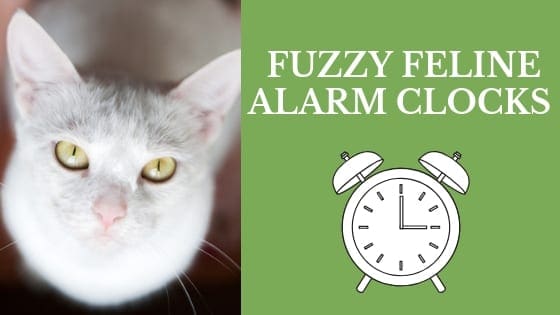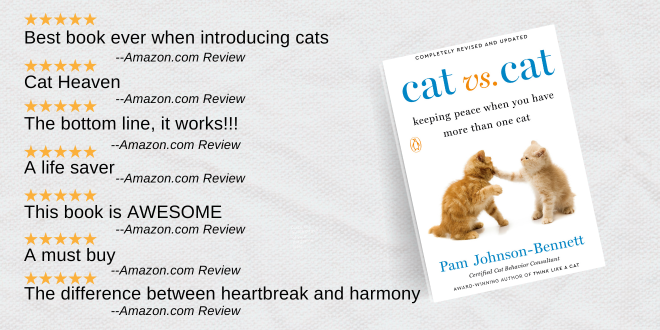
It’s 5am and your cat is sitting on your chest and pawing at your nose. Wake up, wake up, it’s time to play! Well, it’s time to play if you’re a cat but if you’re a sleeping human this is probably last on your list. So why does this pattern repeat itself every time? Why does your cat routinely bite at your toes, paw at your face or systematically push items off the bedside table in the wee hours of the morning? You may not like this answer but it’s actually very normal behavior under the circumstances. First of all, cats are crepuscular, which means they’re most active at dusk and at dawn. Also, for most of us, the end of the day is when we’re winding down so you come home from work, eat dinner, check your email, relax, cuddle with the cat and then head off to bed. The poor cat has been sleeping all day and when you walk through the door at 6pm, he’s ready for the fun to begin. If there hasn’t been adequate stimulation throughout the day through environmental enrichment and you haven’t engaged your cat in playtime in the evening, then at some point you’re going to get reminded of that fact. That reminder comes in the form of 8 lbs sitting on your chest hours before the alarm clock is set to go off.
You Need a Plan
If your cat wakes you up in the middle of the night or at the crack of dawn, there are a couple of things you can do to help “reset” that little fuzzy alarm clock. First on the list though is absolutely the most difficult of all – you have to ignore him when he’s engaging in the unwanted behavior. If you’ve gotten up to put food in his bowl in an effort to distract him then you’ve only succeeded in reinforcing that behavior. If you’ve given attention to a cat engaging in attention-seeking behavior then he now knows that method worked and he’ll repeat it night after night. Even if you’ve yelled at your cat, he’s still receiving some form of attention for the behavior. Animals repeat behaviors that have a pay-off.
If your cat is preventing you from getting a good night’s sleep, try this technique. It’s based on the typical activity cycle that a cat goes through as a natural predator.
1) hunt
2) feast
3) groom
4) sleep
Why This Method Makes Sense
This behavior cycle is based on the typical phases of behavior of the feline predator. For a cat in the wild (or even in your neighborhood), these four phases are necessary for survival. For the indoor cat, following these four phases will help him feel satisfied because they’ll he’ll have the benefit of stimulation, activity, and the food reward, and it will have been done in a way that follows natural behavior. It will make sense to your cat and as a result, you’ll get that much-needed sleep you’ve been missing. Here’s how the four phases work:
Hunt
First, a cat goes through physical activity hunting prey. Out in the wild you won’t find prey just offering itself up as lunch so the cat has to hunt, stalk, and then pounce. This is beneficial physically and mentally for a cat. Cats are also not scavengers so they must seek out fresh prey.
Feast
The cat then feasts on the captured prey. The reward of having a full tummy for a job well done.
Groom
When finished, the feline hunter grooms to remove traces of the prey. This is important in the wild because a hunter doesn’t want to alert other prey to a cat’s presence, nor does he want to risk becoming prey to a larger predator. Cats, because of their size wear both hats — prey and predator.
Sleep
Digestion is next on the list and since the cat has a full stomach that usually means he can afford to take a nap to recharge for the next hunt.
Pam’s Technique
Here’s how you’ll use this behavior cycle to your advantage: Just before bedtime engage your cat in an interactive play session using a fishing pole-type toy. Technique is important here so don’t create a game where you’re waving the wand frantically around and he never gets to capture anything. Creating a frustrated cat isn’t the goal here. Instead, move the toy like prey and allow your cat opportunities to stalk, pounce, and capture. The game should last about fifteen minutes, but you can customize that based on your cat. You also want to customize the game to your cat’s physical ability, age, and health. Remember that playtime is as much mental as it is physical so let your cat have plenty of opportunities to capture the reward. Wind the action down at the end of the game so he is left relaxed and satisfied and not still revved up. The wind-down action at the end of the game is really important so he will be left relaxed and satisfied that he actually killed the prey.
Once the game is done, it’s time for the feast. If you feed your cat on a schedule, divide up the normal daily portion so you can offer a final post-game snack. If you free-feed, take up the food earlier in the evening and then make a big visual display about refreshing the food in the bowl.
After the meal, your cat will most likely engage in a grooming session and then he’ll be ready to snooze.
Provide Nighttime Toys
If you find your cat still wants interaction or isn’t relaxed enough, then after the game you can set out special toys that only make an appearance in the evening. These can be food-dispensing toys, other puzzle toys, or whatever safe toys your cat enjoys for solo playtime.
Spruce up the Environment
In addition to the four-part behavior cycle, set up the cat’s environment so that there are activities available should he wander around the house looking for more stimulation. Hide treats in puzzle feeders or in boxes (such as empty tissue boxes). You can even make homemade puzzle feeders with plastic water bottles or the cardboard inserts from toilet paper or paper towels.
Provide a cat tree, window shelf, hammock bed, or some other resting area for your cat to watch the evening activities taking place outdoors. Depending upon where you live, perhaps you can leave the drapes open at one window.
Wall shelves, cat skyways and other climbing/perching additions can be added to the interior environment. Depending on your budget, you can purchase sturdy walkways or construct some of your own. Cats love elevation and if you increase your cat’s vertical territory you can provide more opportunities to climb play and view the environment.
Some cats don’t adjust well to how the house suddenly gets dark and quiet at night. If you think your cat may be reacting to the lack of activity in the night, leave soft music playing in the main part of the house, use nightlights or put lights on timers.
Remember, your cat naturally seeks stimulation and activity. Provide adequate environmental enrichment and don’t skimp on your daily interactive play therapy sessions.
The bottom line is to ignore the behavior you don’t want but also set your cat up to succeed by recognizing the natural, normal needs, and creating opportunities for stimulation.
Need More Information?
For more information on cat behavior and training, check out the best-selling books by Pam Johnson-Bennett. Pam’s books are available at bookstores and online. We’ve included Amazon links here on our website.
If you have a question regarding your cat’s health, please contact your veterinarian. This article is not intended as a replacement for your cat’s veterinary care.




